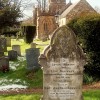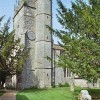“A half-dead townlet” was how Thomas Hardy once described Bere Regis. Perhaps this townlet, situated amid woodland and heath at the junction of the A31 and A35 may indeed have not changed much in the eyes of locals since Hardy expressed his opinion.
The ‘Bere’ part of the name derives from the river, and possibly the drink, while other authorities consider the origin to be Saxon byri, meaning a fortified place, or byre, the Norse word for a group of buildings. But most likely it derives from the Old English word for a wood or copse. It is said King John, who visited the estate several times, drank beer, suggesting the connection with name. The ‘Regis’ element simply indicates the royal connection.
Long before King John the area clearly saw intensive prehistoric settlement, for 50 Bronze Age round barrows have been recorded, including the un-excavated Hundred Barrow, 75 metres south of the church. Nearby Woodbury Hill was early fortified with one rampart as an oppida during the Iron Age, and the area has further been identified with the site of the Roman Station of Ibernium, Wood Fort being the Castra or summer camp. The Hill still retains traces of the encampment, which on clear days commands strategic views of Purbeck and Poole.
Bere was anciently a Royal demesne. The Saxon Queen Elfrida had a seat here to which she retreated after the murder of her son-in-law Edward (the Martyr.) As Bere was already a Royal estate at the time of Domesday in 1086 it was not included in William 1’s famous land survey, but the manor remained a Royal possession until 1269. From the 13th century the Lords of the Manor were the Turbervilles, and Simon de Montfort, father of the English Parliament, made his home here.
There has been a stone church at Bere since the mid 11th century, but the present church of St. John Baptist was fully developed through additions and alterations by the 17th century. The two most notable features of the church are the Turberville Window in the south aisle and the “12-Apostle” hammer-beam roof, constructed by Cardinal John Morton about 1485. The village also has a Wesleyan chapel, a hall for the independents and two meeting houses for dissidents.
Bere Regis owes its first market to King John, who granted a charter in 1215, though today the market has fallen into disuse. At Woodbury a fair was held from 1267. By this century however the village had grown to town status, but at no time since has its development reached town status by modern standards. Today the parish incorporates Shitterton (a hamlet at the west end of Bere;) Roke (or Roake;) Hollow Oak and Bec Heath.
Cottages in the village are predominantly two story with thatch, and walls of cobb or flint and brick courses. Barns are of similar building materials. During the 17th, 18th, and 19th centuries some houses were built, but one 19th century thatched cottage survives. At the peak of its prosperity Bere once had twelve shops and six filling stations. Today there are just two general stores, two pubs (especially the Drax Arms, named after a land-owning family in the district;) one post office, and one filling station on the bypass; a health clinic, dentist and chiropodist. But the village was twice nearly consumed by fire, first in 1634 and again in 1788. Because of the fires the present centre of Bere mostly dates from the late 18th century, when the properties along the high street were re-built as terraces of plain Georgian cottages. Along the street at Shitterton, which was less affected by the fires, more of the original cottages survive. Thomas Williams founded a charity school for the education and clothing of eight boys.
The Royal Commission for Historic Monuments survey for Dorset records nine 17th century houses; nine 18th century houses/cottages, and eight houses of the 19th century, together with some 19th century barns. Roke Farm is a listed building on an L-shaped plan originally built in the 18th century, but altered in the 19th. Little evidence remains today of the influence of King John and the Turbervilles.
Other than agriculture, Bere’s traditional industries have been building, brick-making, cutting wood for faggots, and cress-growing in beds to the south fed by the Bere stream. In its demographics Bere reflected a national trend, with its greatest spurt of population growth occurring during the 19th century. The ten-yearly census records a rise from 936 in 1801 to 1,170 in 1831 and thence to a peak of 1,494 in 1851. But industrialisation of the north precipitated a rural decline thereafter. Indeed, rural riots which erupted in 1830 first broke out here (they were ruthlessly suppressed by James Frampton, who would be the chief prosecutor of the Tolpuddle Martyrs only four years later.) The decline did not begin to reverse until after World War 1, when the population began a steady rise, which continues today.
But over twenty years ago Bere’s then present and future development and housing needs were thrown open to public consultation. In May 1982 – incidentally the year the bypass was opened – the Parish Council set up a sub-committee to consider the development of the Regis in the closing decades of the 20th century. After consultation with Purbeck District Council, Dorset County Council, and COSIRA, the committee studied the Dorset Structure Plan and organised a survey of the villager’s opinions/ Sections on Environment, Housing, Public Services, Employment, Youth and Recreation were all included. Although the questionnaires were distributed to most homes, fewer than 50% of them were returned completed. This made the accuracy of the results which were obtained rather suspect.
The survey did find however, that over thirty buildings were listed. It appeared that many residents thought there were too many council houses and at too high a density, though most (90%) thought the newest housing was visually compatible with the older traditional buildings. An overwhelming demand for low-cost private homes (though not flats) also emerged from the survey, as did the opinion that there were too few shops. Building materials, the participants stated, generally harmonised with the vernacular building fabrics. Influenced by the results the survey committee aimed to site all future homes on brownfield land or inner waste ground to avoid village sprawl. Some lost shops have been restored. But today the bypass has gone some way to preserving Bere Regis as a quiet precinct relatively unflustered by tourists.



